What is Facial psoriasis?
Facial psoriasis is a chronic skin condition in which there are one or more, persistent, thickened, red and dry patches on the face.
Psoriasis is a common chronic inflammatory skin disease that may affect any skin site. Facial involvement occurs at some time in about half those affected by psoriasis. Although it is usually mild, facial psoriasis is occasionally very extensive involving the hairline, forehead, neck, ears and facial skin.
It is extremely rare to have psoriasis occurring solely on the face. Most patients also have scalp psoriasis and they may also have moderate to severe psoriasis at other sites.
Patients with facial psoriasis often suffer from psychosocial problems due to the presence of unsightly red, scaly plaques on highly visible areas
Facial involvement presents as a therapeutic challenge because facial skin is thin, sensitive and more complicated to treat
What are the clinical features of facial psoriasis?
Facial psoriasis has various clinical presentations. There are three main subtypes:
- hairline psoriasis
- sebo-psoriasis
- true facial psoriasis
Hairline psoriasis
- An extension of scalp psoriasis beyond the hairline onto facial skin
- Bright red, thickened plaques with variable white scale
Sebo-psoriasis
- Patchy involvement of hairline
- Often affects eyelids, eyebrows, nasolabial folds and beard area
- Salmon pink, thin plaques with bran-like scale
- Usually associated with diffuse or patchy scalp psoriasis
- Psoriasis may or may not be present at other sites
True facial psoriasis
- Sharply demarcated, red, scaly plaques
- May affect any part of face
- Tends to be symmetrical
- Associated with psoriasis at other sites including ears, genitals, scalp, elbows, knees, trunk
- Can be part of plaque psoriasis, guttate psoriasis or erythrodermic psoriasis
Symptoms of facial psoriasis
- Mild to intense itch
- Soreness and skin sensitivity, which are usually mild
What causes facial psoriasis?
The causes of facial psoriasis are the same as for psoriasis in general. Psoriasis is associated with inappropriate activation of the immune system resulting in inflammation and increased proliferation of skin cells. There is a genetic predisposition, but environmental influences are important, including stress, infection, injuries and certain medications.
Facial psoriasis may also be aggravated by:
- ultraviolet radiation - some patients have photosensitivity, i.e. the psoriasis is aggravated by exposure to the sun
- skin flora, particularly the yeast malassezia smoking.
What is the management of facial psoriasis?
There is no cure for facial psoriasis, but satisfactory control of the disease is possible for most patients using topical therapy. General skin care may include:
- Gentle non-soap cleansers
- Moisturisers
- Sunscreens, if required.
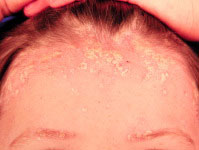
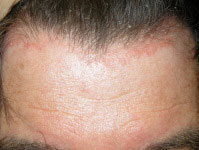
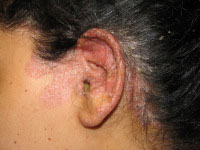
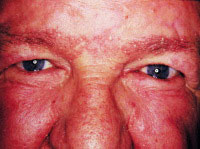
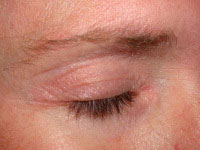
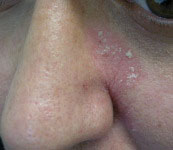
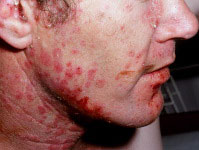
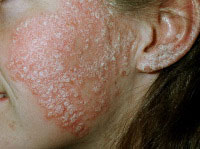
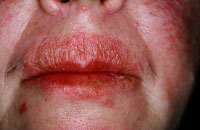
Corticosteroid creams
Mild to moderate potency topical steroids reduce inflammation and relieve itching. Side effects of corticosteroids restrict the potency and duration of use on the face. These include:
- periorificial dermatitis (spotty acne-like rash around mouth, nose and eyelids)
- easy bruising and tearing of skin
- thin, transparent skin especially if eyelids are treated
- telangiectasia (enlarged blood vessels)
- rarely, increased hair growth (hypertrichosis)
- risk of glaucoma and cataracts from long-term use of potent steroid creams around eyelids.
Hydrocortisone is generally safe. More potent topical steroids are best used on the face for only a few days each month.
Topical calcineurin inhibitors
The topical calcineurin inhibitors pimecrolimus cream and tacrolimus ointment may be prescribed off-label for facial psoriasis and can be very effective. They are particularly useful on eyelid skin. In New Zealand, these preparations are not currently subsidised by PHARMAC (April 2012).
Other topical preparations
- Salicylic acid is a descaling agent found in many over-the-counter creams.
- The vitamin D analogues, calcipotriol/calcipotriene and calcitriol, tend to irritate facial skin. Cream formulations may be tolerated, especially in combination with topical steroids.
- Coal tar creams may cause staining and irritation.
Phototherapy
Sun exposure or prescribed phototherapy is often very helpful for facial psoriasis.
It is unwise if there is photosensitivity or significant sun damage, such as solar/actinic keratoses or skin cancer.
Systemic treatment
Severe facial psoriasis sometimes warrants treatment with tablets or injections such as methotrexate, ciclosporin, acitretin or biologic agents. Patients should be under the care of an experienced dermatologist and should be carefully monitored.
What is the prognosis?
Facial psoriasis tends to persist, although its severity may vary with season, stress and other factors. It may be a marker of more severe disease with early onset, long duration and more extensive plaques.
